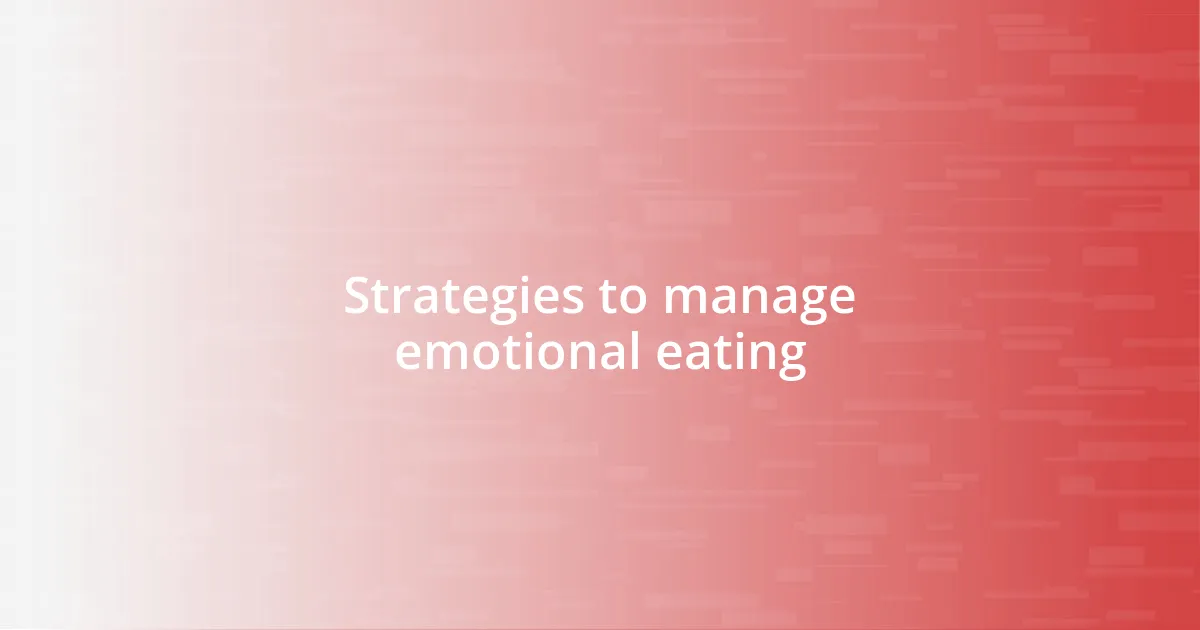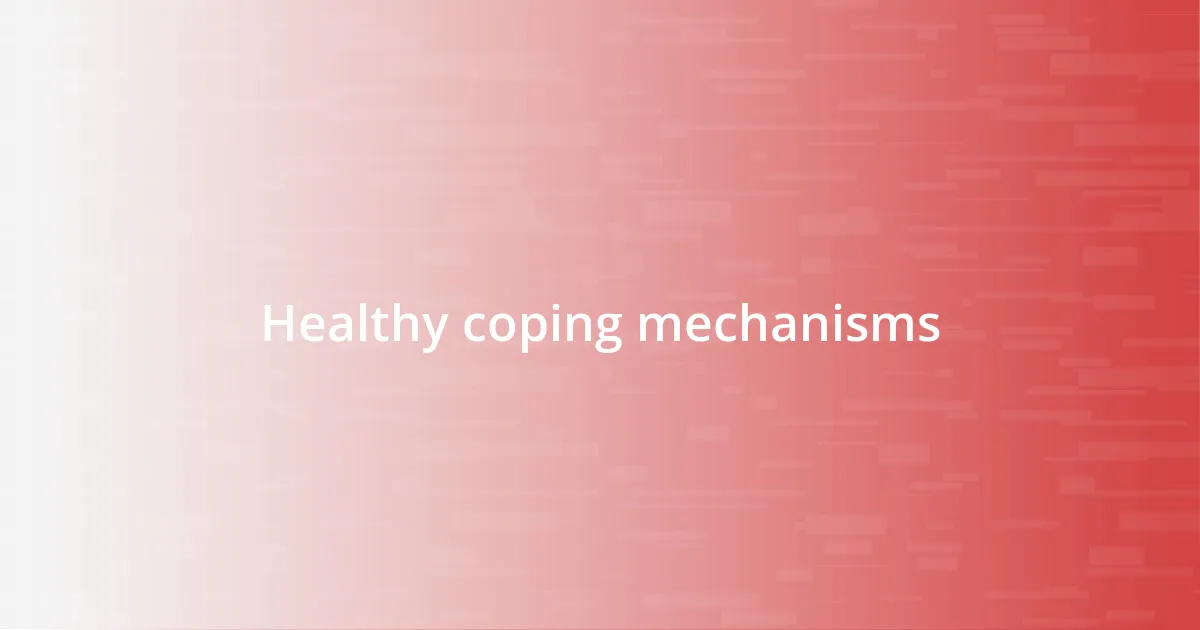Key takeaways:
- Emotional eating often stems from feelings like stress, boredom, or loneliness, rather than actual hunger, and recognizing these triggers is crucial.
- Strategies such as keeping a food journal, finding alternative coping mechanisms, and practicing mindfulness can help manage emotional eating effectively.
- Engaging in creative hobbies and physical activities like yoga can provide healthy outlets for emotions, reducing the urge to seek comfort in food.
- Practicing gratitude and mindfulness during meals enhances the eating experience and helps cultivate a positive relationship with food.

Understanding emotional eating
Emotional eating is often a response to feelings rather than hunger. I remember a particularly stressful week at work when I found myself reaching for cookies late at night. It’s fascinating how sometimes we turn to food for comfort, hoping to soothe our emotional state, even when we’re not physically hungry.
It’s not just about the food; it’s about the feelings we associate with it. Have you ever noticed how certain flavors can transport you back to specific memories? I often think of the homemade lasagna my grandmother used to make. That rich, warm aroma enveloped my home and wrapped me in a sense of belonging, making it easy to reach for a second helping, not to fill my stomach but to fill an emotional void.
Understanding emotional eating means recognizing these triggers and patterns. When I find myself craving a snack after a long day, I pause to ask myself, “Am I actually hungry, or am I just tired and in need of a break?” This self-reflection helps me untangle the connection between my emotions and my eating habits, allowing me to better manage those moments when I seek comfort in food.

Triggers of emotional eating
Triggers can amplify our tendency to turn to food for emotional relief. I’ve often noticed that feelings of stress, boredom, or sadness prompt me to seek solace in snacks. It’s oddly comforting, yet I understand it’s a fleeting fix for deeper emotions. Recognizing these triggers is a crucial step in managing emotional eating patterns effectively.
Here are some common triggers that might resonate with you:
- Stress: When life gets overwhelming, food can feel like an instant relief.
- Boredom: Sometimes, I find myself snacking just to fill time, rather than from hunger.
- Loneliness: In moments of solitude, I often seek comfort in food, which can feel like companionship.
- Celebration: Paradoxically, happy occasions can also lead me to indulge, linking joy with food.
- Fatigue: A long day at work leaves me craving anything that brings a jolt of comfort or energy.
By identifying these patterns, I’ve learned to explore healthier avenues for dealing with emotions rather than defaulting to food as a comfort.

Signs of emotional eating
Recognizing the signs of emotional eating is vital for understanding our relationship with food. For instance, I’ve noticed that when stress creeps in, I tend to find myself in front of the fridge, absentmindedly reaching for whatever I can find. It’s alarming how quickly that moment of stress can lead to an empty bag of chips, far removed from my original intentions.
Another telling sign is the sudden urge to eat when I’m experiencing heightened emotions. There have been instances where, after a tough conversation with a friend, I’ve dove into a pint of ice cream. In those moments, I’m not really enjoying the treat; it’s more about drowning my feelings rather than savoring the flavor. This disconnection between my emotions and my eating habits serves as a clear indicator of emotional eating.
Additionally, I find that eating without being aware of what I’m consuming can be a major red flag. Once, after a rough day, I mindlessly munched on popcorn while watching TV. I didn’t even realize how much I had consumed until the bowl was empty. This engagement in mindless eating further emphasizes the need for mindfulness in our eating habits.
| Signs of Emotional Eating | Examples |
|---|---|
| Stress-Induced Eating | Reaching for snacks during stressful moments. |
| Emotional Aftermath Eating | Indulging in comfort foods after negative experiences. |
| Mindless Consumption | Eating while distracted, often consuming larger amounts. |

Strategies to manage emotional eating
I’ve found that one of the most effective strategies for managing emotional eating is to keep a food journal. This simple practice has transformed my understanding of what I crave and why. By jotting down not just what I eat, but my emotional state at the time, I’ve uncovered patterns that help me make more conscious choices. Have you ever thought about what drives your food cravings? Discovering your emotional triggers can be eye-opening.
Another approach I’ve adopted is finding alternative coping mechanisms that bring me joy without involving food. For example, when I feel the pull to snack out of boredom, I often opt for a quick walk or dive into a good book instead. These activities provide the same kind of relief I seek from food, but they also leave me feeling invigorated and fulfilled, rather than guilty or stuffed. Isn’t it amazing how a simple shift in routine can change your outlook?
Finally, I’ve learned to practice mindfulness during meals, which has greatly helped in managing my emotional connection to food. Eating slowly and savoring each bite allows me to truly enjoy my meal rather than using it as a distraction. I often find that when I focus on the flavors and textures, the urge to overindulge diminishes. Have you tried being present with your food? This small shift can help cultivate a more positive relationship with eating.

Healthy coping mechanisms
Exploring healthy coping mechanisms is essential in breaking the cycle of emotional eating. I recall a time when I decided to channel my stress through painting instead of reaching for snacks. The simple act of putting brush to canvas not only distracted me but allowed me to express emotions I hadn’t yet processed. This experience opened my eyes to how creative outlets can serve as a powerful alternative to food. Have you ever considered how hobbies could shift your focus away from cravings?
Additionally, I’ve started incorporating physical activity into my routine, particularly yoga, which has been transformative for my emotional well-being. After a challenging day, I find that rolling out my mat and focusing on my breath helps me release tension and connect with my body. It’s interesting how movement can ground us and redirect our thoughts, isn’t it? Instead of searching for comfort in food, I’ve learned to find it within myself through mindful practice.
Lastly, I can’t stress enough the value of seeking support from friends or professionals. When I was grappling with emotional eating, chatting with a trusted friend helped me gain perspective and accountability. Sharing my experiences made me feel less isolated, allowing me to understand that I wasn’t alone in this journey. Have you ever thought about reaching out to someone who could understand your struggles? Sometimes, talking openly can bring light to feelings we may not even realize we’re holding onto.

Mindfulness techniques for emotional eating
I often find that grounding exercises can significantly help me navigate moments of emotional eating. For instance, when I notice the urge to snack without real hunger, I take a moment to close my eyes and focus on my breath. Deep, intentional breathing helps me reconnect with my body and recognize if I’m truly hungry or if I’m simply seeking comfort. Have you ever taken a few moments to breathe and simply check in with yourself? It can be a powerful practice.
One technique that has greatly aided my mindfulness journey is the practice of mindful eating. Instead of diving into a meal with distractions, I try to create an environment that allows me to fully engage with my food. This might mean sitting down at the table, away from screens, and appreciating the colors and aromas of my meal. I’ve realized how much more satisfying it is to eat this way—often, I find myself genuinely enjoying every bite. Doesn’t it feel more fulfilling to eat with intention rather than mindlessly?
Lastly, I’ve embraced the act of gratitude in my relationship with food. Before each meal, I remind myself of the nourishment it provides and the care that went into its preparation. By expressing gratitude, I shift my focus from emotional triggers to appreciation for what’s on my plate. This simple yet profound practice has not only diminished my cravings but has also enhanced my overall relationship with food. Have you tried to pause and reflect on what you’re eating? It can transform your dining experience and reduce the impulse to eat emotionally.















